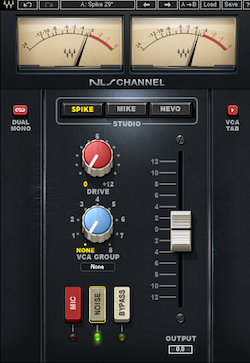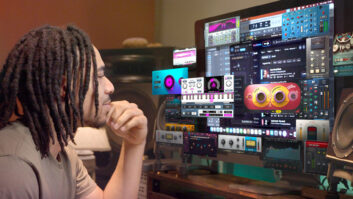
Oh, how I love plug-ins these days. The latest crop of analog emulators impresses me more than ever. Waves ups the ante with Non-Linear Summer (NLS), a bundle that virtually Xeroxes the sounds of three classic consoles owned by studio luminaries: Mark “Spike” Stent’s SSL 4000G, Mike Hedges’ EMI TG12345 and a custom-made Neve 5116 in the clutches of Yoad Nevo. The bundle comprises two constituent plug-ins, NLS Channel and NLS Buss, which respectively model the three consoles’ input channels and master buses. Within each plug-in instance, you select which of the three consoles you wish to summon.
The cross-platform NLS is available in TDM, AU, VST, VST3, RTAS and AudioSuite formats and supports 32- and 64-bit hosts. I reviewed the AU plug-ins in Digital Performer 8.01, using an 8-core Mac Pro running OS X 10.8.2.
Variety Is the Spice
Waves modeled more than 100 individual channels of Stent’s, Hedges’ and Nevo’s distinguished boards to brew up NLS Channel. When you instantiate NLS Channel on your DAW’s mixer insert (typically on the first or last insert for a track) and select which of the three emulated consoles you want to use, one of 32 modeled channels for that particular console is loaded. On each successive instantiation, NLS Channel recalls a different channel of the same analog board. (But if you copy an instance of NLS Channel in your DAW to another mixer channel, you’ll get exactly the same model.) This ensures your project is imbued with the channel-to-channel variations in frequency response, THD, noise and clipping behavior that the circuitry in the real console would impart, rather than painting every channel with exactly the same coloration. Inherent latency is only four samples (inaudible).
The second component plug-in in the NLS bundle, NLS Buss, should be placed on an insert for your master bus or an aux channel (for example, a subgroup for drums).
NLS Channel offers an easily grasped control set (see Fig. 1). The Studio button selects the console type, Drive adds harmonic distortion (while simultaneously decreasing headroom), output adjusts gain (up to ±12 dB) and VCA Group assigns the plug-in instance to a group. You can unlink a stereo instance of NLS Channel so that its left and right channels don’t recall exactly the same model. Click on the mic switch to simulate mic-input level (rather than the default line level), changing the plug-in’s headroom. The plug-in’s bypass button nulls the model’s frequency response, harmonic distortion and noise. You can also turn modeled noise on or off separately for each plug-in or its group. VU-style meters show peak output levels, with 0 dB (needle full right) ostensibly equating to full-scale signal.
NLS Buss offers the same controls as NLS Channel, with the following exceptions: a Trim control is substituted for the output-gain knob, and there is no link or mic switch. The trim control boosts or attenuates gain up to 12 dB.
You can group multiple NLS Channel and Buss instances for simultaneous control of their common parameters: drive and trim amounts, console type, and bypass and noise activation. The groups—as many as eight—are viewed and managed in a VCA Group Console display you can open from within each plug-in’s GUI (see Fig. 2). Each group can be named (for example, “Drums”).
Plug-in instances within the same group can use the same or different virtual consoles; this allows control over their common parameters while retaining their unique console selections. A group’s drive and trim settings offset (add to or subtract from) the values of the respective control settings for its constituent plug-in instances. For example, if the kick drum’s drive setting is set to +3 and its VCA Group’s drive value is -1, the kick’s actual drive value is +2 (3–1=2). An individual plug-in’s noise and bypass settings are overridden by those made for their group. Only one group can be automated in any given session.
Board Walk
As I instantiated NLS on successive tracks, a different NLS mixer channel was automatically chosen for each instance, and its console type and channel number (for example, “Nevo 02”) was conveniently displayed in NLS workspace A. Nice!
NLS used my CPU resources very efficiently: Use on more than 40 tracks (along with over 30 other plug-in instances) in 64-bit mode never caused the processing meter in DP8 to spike or clip.
Boosting NLS’s drive controls also increased output gain. I used the trim controls to compensate. There was no way to link the drive and trim controls (on either the individual plug-in or its group), nor was there any auto-gain compensation for the drive effect, so I had to constantly reset the trim after adjusting the drive up or down for the saturation I wanted. The plug-in’s meters have slow ballistics and can miss transient peaks, so keep an eye on your DAW’s clip indicators; NLS lacks these.

NLS Buss can be assigned to any of the same eight VCA groups as NLS Channel, or to none. This excellent design allows you to audition different console types on your master bus while using NLS Buss’ VCA Groups Console display to control the drive, trim, bypass and noise for all NLS Channel groups—all in one window.
Outstanding, Versatile Sound
Inserting NLS Channel on individual tracks, the Mike (EMI console) models sounded fantastic on electric guitar. Driven hard, they produced gnarly, authentic-sounding, transistor-like distortion. The Nevo (Neve) models were my favorite on rock drums and bass. Pushed hard, they made the drums sound trashy—without thinning—and the bass burpy. Electric guitars also sounded great on Nevo where I wanted a round but present tone with some hair on it. Vocals and acoustic instruments sounded beautifully clear with Spike (SSL) modeling, using light processing. These are just a few of the many applications NLS Channel excelled on. The wide compass of tones the drive control produced on the models for each of the three consoles ranged from subtle to drastically distorted. Activating the mic switch on NLS Channel pushed distortion over the top.
Each NLS Buss console—inserted on my master bus in turn—added subtle effect until I raised its drive control about halfway (to “6”). With this setting, Spike sounded the clearest and cleanest of the three models, lending tight bass and open midrange; the downside is it also made some instruments, such as snare drum, sound slightly thinner and paper-y. The Mike model produced a slightly fuller low-midrange and leaner upper-midrange band. It sounded more colorful than Spike; when driven moderately, it lent a subtle spanked sound that firmed up the mix and made high frequencies sound nicely ping-y. Nevo—perhaps my fave—sounded slightly warmer, rounder and fuller than the other two models. Nevo saturated the highs, making them sound less clinical but also less sparkly. It also brought the midrange forward (great for guitars!) and tightened the bottom end.
Of the three models, Mike saturated most readily; boosting the drive control too generously produced nasty distortion long before clipping occurred at the DAW’s output. I could drive Nevo and Spike much harder without the mix completely falling apart. At high drive levels, Nevo needed the least amount of compensatory trim to avoid clipping DP’s output and therefore produced the loudest masters. Spike processing actually reduced headroom; follow it with a limiter or maximizer to make your mix sound louder again.
Compared to What?
The most obvious product to compare NLS to is Slate Digital Virtual Console Collection (VCC). VCC is terrific but sounds relatively subtle; NLS can produce a much wider range of outstanding tones. And because NLS Channel is so efficient in its CPU use, I can use it on far more tracks than VCC. In its favor, VCC automatically regulates its output level for unity gain when its drive control is adjusted, making it much easier to use compared to NLS.
Both products are fabulous, but I have to give the rose to Waves NLS because of its exceptional versatility and superior coding. NLS is the leading-edge plug-in for console emulation.
PRODUCT SUMMARY Company: Waves
Product: Non-Linear Summer (NLS)
Website:waves.com
Prices: $249 Native, $349 TDM (list)
Pros: Superb, highly variable sound. Flexible channel grouping. Low CPU hit allows use on dozens of tracks.
Cons: No auto-gain or trim link for drive adjustments. Meters lack clip indicators.
TRY THIS
Color tracks for drums and electric instruments with heavily driven Mike and Nevo models. Use the Spike model with light processing on acoustic tracks and vocals. The contrast between luster and clarity will give your mix flattering depth.




